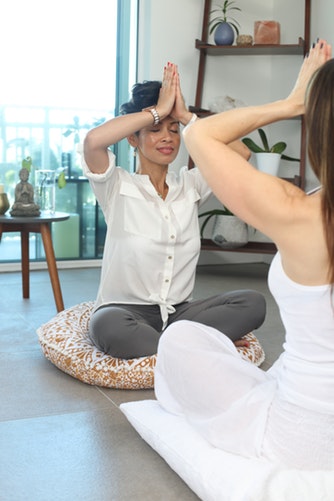Incredible Benefits of Meditation Therapy
What is Meditation?
 Meditation is relaxation of the mind, body, and spirit by focusing on either your breathing, the sounds around you, or the present moment. The focus of meditation can vary depending on the types of meditation you choose to participate in.
Meditation is relaxation of the mind, body, and spirit by focusing on either your breathing, the sounds around you, or the present moment. The focus of meditation can vary depending on the types of meditation you choose to participate in.
Different Types of Meditation
Primordial Sound Meditation- calms the mind and body by emanating simple sounds such as soft music, ringing bells, a soothing voice, or white noise.
Mindfulness-Based Stress Reduction- developed in 1979 by Dr. Jon Kabat-Zinn, this form of meditation is an eight week course created to allow people to become more aware of their habitual reactions. MBSR involves focusing on your whole body, from your head to your toes, also known as a “body scan”. During the body scan you might notice how your shoulders tense up, or random thoughts/distractions pop into your head. By becoming aware of these things we are able to release tension or stress by letting go of thoughts or purposely relaxing your shoulders.
Yoga- this is the most common way of meditation. Not only does yoga increase flexibility and muscle strength, but it also improves mental clarity while relieving chronic stress.
 Practicing these simple meditation techniques can drastically improve your behavior and overall reflection of yourself and the world. Meditation is said to have helped millions of people all over the world suffering from a variety of different illnesses such as anxiety and depression, insomnia, high blood pressure, Ulcerative Colitis, heart attacks, etc.
Practicing these simple meditation techniques can drastically improve your behavior and overall reflection of yourself and the world. Meditation is said to have helped millions of people all over the world suffering from a variety of different illnesses such as anxiety and depression, insomnia, high blood pressure, Ulcerative Colitis, heart attacks, etc.
Simple Steps of Meditation
Just about anybody can participate in meditation, some techniques do require physical movement, but others require no movement whatsoever. Most people have the common misconception that meditation consists of sitting crisscross on the ground with your hands rested on top of your knees. Although this is a form of meditation, there are plenty of other ways to meditate that require no sitting at all. It is possible to meditate anywhere at any time, all you have to do is follow these simple steps:
Step 1: Allow yourself to be in a position where your energy can flow smoothly throughout your entire body. If you are in an uncomfortable, or straining position it can be difficult for your body to relax. Position yourself wherever, or however is comfortable to you. There is no set way to meditate, so long as your body and mind can be relaxed, you may choose whichever position suits you best.
Step 2: Find a “meditation time”. Whether you decide to meditate in the morning before your day starts, or in the evening to unwind from all of the chaos, depending on when you decide to meditate will depend on what type of meditation you will be doing.
Step 3: Length of meditation. For beginners, it is best to start with a short 5-10 minutes of meditation, and gradually move up to the common 15-30 minutes. Keep a consistent time length of meditation. It is possible to meditate too much, so keeping it to about once or twice a day would be ideal.
Step 4: Being silent and calm can often lead to random thoughts popping in and out of your head. This is normal, do not try to force these thoughts, whether negative or positive, out of your mind. Allow them to come and go naturally and imagine them entering into a cloud and drifting away peacefully.
Step 5: Sound. During meditation, dealing with noise is similar to dealing with your thoughts. Allow the noise to enter and leave naturally, without trying to block it out. Sound meditation is actually a very popular practice that most people find helpful. Following the sound of your breathing or somebody’s voice can help calm the mind and create a point of focus during meditation. Sound and light meditation therapy, suggested by Dr. Nick Delgado, http://www.delgadonaturals.com/lfc-brainwave-glasses-w-sleep-mask/, will allow the brain to become more focused and concentrated throughout the day.
Step 6: Finishing your meditation. When ending your meditation it is important to slowly pull yourself back into reality. It can be alarming for your body to go from a calm, relaxed state, to sudden hyperactivity. Take your time to come out of meditation. Stretch out of the position you are in, slowly engage in small movements, and lastly, open your eyes when you feel ready.
These simple meditation guidelines will have a drastic effect on the outlook of your day, based on the positive mood you are in. Practicing these steps for at least ten minutes a day will decrease your body’s anxiety and open your mind to new and exciting possibilities. Meditation will allow you to view yourself, and the world around you with more of a pleasant and inviting demeanor.
To learn more about meditation, or other health benefits, please visit http://www.nickdelgado.com/blog/
References:
https://nccih.nih.gov/health/meditation/overview.htm#hed2
http://www.meditationoasis.com/how-to-meditate/general-guidelines
http://www.freemeditation.com/meditation-basics/
https://www.universalclass.com/articles/self-help/how-sound-therapy-plays-a-role-in-relaxation.htm
http://www.webmd.com/balance/features/meditation-heals-body-and-mind
http://www.meditationoasis.com/how-to-meditate/general-guidelines
Article written by: Jade Whelchel





